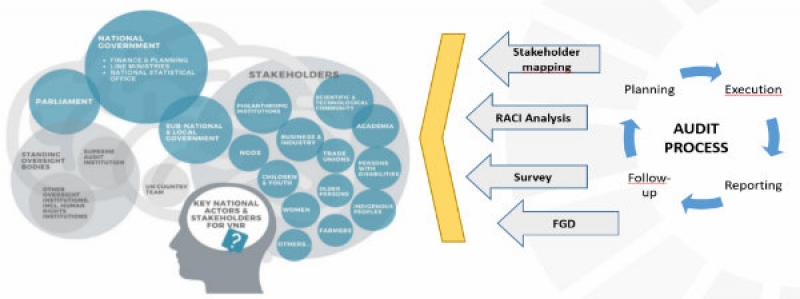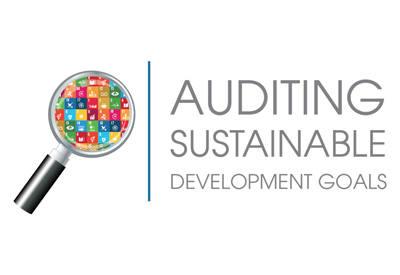About IDI
Our Cross-Cutting Priorities
Our Results
Meet the IDI Board
IDI's Board is composed of ten members from different supreme audit institutions. Get to know them better in our "Meet the Board" series.

About 73 SAIs and one subnational audit office are participating in a capacity development program on ‘Auditing Sustainable Development Goals.’ They have been working with a new audit approach that will enable a wider involvement of stakeholders in examining participation and making sure no one is left behind in the implementation of the SDGs.
The World Public Sector Report 2018 mentions the articulation of stakeholder engagement. This report addresses mechanisms that support participatory, multi-sectoral, and multi-level problem solving, all of which are needed to achieve long-term integrated approaches. These approaches must involve a wide range of stakeholders, including various levels of government. Adhering to the principle of “leaving no one behind,” as enshrined in the 2030 Agenda for Sustainable Development, also requires engagement with the full range of diverse stakeholders, with a particular focus on marginalized groups and individuals.
Experience from the cooperative performance audit on the preparedness for the implementation of the SDGs has demonstrated the importance of stakeholder engagement when assessing the national systems’ readiness to report on the level of progress towards achieving the SDGs.
To observe this, the program has provided audit teams with techniques and information on how to consider stakeholder engagement in their audits. This was then put into the three audit objectives, which together comprise the adaptation of the 2030 Agenda into a national context, secure the means of implementation, and establish a mechanism on monitoring, follow up, and reporting on the progress towards the implementation of the 2030 Agenda.
The cooperative performance audit encouraged the audit teams to expand their audit methodology, which could answer the need to capture a complete picture of the SDGs in their national context. One audit tool the audit team used was stakeholder mapping, which could identify relevant stakeholders in terms of their role(s), interest, and influence in the arrangement of the SDGs. This tool is combined with the RACI analysis, which enables the team to assign somebody responsible, accountable, consulted, or informed for all activities undertaken in the institutional arrangement of the SDGs.
The audit team also explored audit techniques that can incorporate an increased level of participation by stakeholders, such as an extensive survey and the focus group discussion to observe stakeholders’ perceptions of the SDGs.
As one of the participating SAIs, SAI Saint Lucia conducted a survey during the audit process to determine the public’s awareness of the SDGs.
The audit team noted various observations of the public in terms of its understanding of, involvement in the preparation of, interest in, and ownership of the SDGs. SAI Saint Lucia found that the majority of the people surveyed have not been involved in or informed about the 2030 Agenda. Of those surveyed, 62 percent were not aware of the term SDGs.
SAI Saint Lucia’s finding also revealed that, of the 38 percent of people who were aware of the SDGs, 78 percent indicated that they did not have a full understanding of the goals, in that they could not name any of the 17 goals and were not aware of any preparation initiated by their government for the SDGs. This is an indication that the sensitization drive did not fulfill its goal.
The survey also revealed that even though the majority of the public was not aware of or involved in the SDGs, the public is still interested in the SDGs. Of those surveyed, 88 percent indicated that they would attend meetings and workshops aimed at informing them about the goals, and 95 percent indicated their interest in getting more information. Also, 98 percent believe the SDGs will have a positive impact on the citizens of Saint Lucia.
The audit conducted by SAI Saint Lucia indicated that engagement with stakeholders has led to understanding stakeholders as beneficiaries and monitoring agents in SDG implementation that could contribute direct knowledge of how services and programs work for them in practice.
Another lesson learned from the way the audit team explored stakeholder engagement was through SAI Bhutan’s and SAI Indonesia’s use of stakeholder mapping and RACI analysis to understand the institutional arrangements and the participatory process of monitoring and evaluating the SDGs.
Using these methods, SAI Bhutan identified the roles and interests of the private sector, civil society organizations (CSOs), and marginalized groups in creating ownership for the implementation of the SDGs. SAI Bhutan found no separate consultation and review in preparation to implement the SDGs, and no interface for the private sector, CSOs, and marginalized groups to engage with as well as account for their contributions towards nation-building and the SDGs. Consequently, the government and the Gross National Happiness Committee (GNHC) have not engaged the citizens and various stakeholders in promulgating the principles of their SDGs and their role in the national planning process.
The interviews SAI Bhutan did with the private sector and CSOs indicated that relevant government agencies had no formal awareness about the SDGs. Apart from the presentations and discussions, no other channels of communication—including radio, TV, newspapers, and leaflets—were used. GNHC stated that these channels were not feasible due to the lack of an identified agency to lead communication initiatives.
SAI Indonesia conducted an extensive focus group discussion with a university that serves as the SDGs Research Center in Indonesia, in order to obtain a comprehensive understanding of academia’s perspective of the SDG platform in Indonesia. SAI Indonesia then used this discussion as relevant information in audit planning and execution. Based on its analysis, the team developed further analysis on how to best formulate the institution to promote multistakeholder engagement.
SAI Indonesia also interviewed key actors regarding the process of raising awareness, using stakeholder mapping and RACI analysis of related documents, such as communication strategies, minutes of meetings, and the SDGs Secretariat’s working papers. The audit team found that the participation of the marginal community in Indonesia should be enhanced in raising awareness, while the operational details of communication strategy also need to be developed to clarify the guidance.
From the experiences shown above, SAIs may have to look beyond their traditional mechanisms when collecting evidence by consulting with a wider set of stakeholders throughout the audit process. This will allow SAIs to examine participation in SDG implementation and ensure no one is left behind.
Stakeholders expect more from SDG audits to capture their involvement in the implementation of the SDGs. By including stakeholders’ needs and expectations, audits would generate value for citizens and make the work of SAIs more relevant.
| For more information about IDI's Auditing the SDGs initiative, please click on the logo. |  |